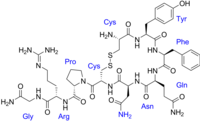
Photo from wikipedia
On the one hand, sustained β-adrenergic stress is a hallmark of heart failure (HF) and exerts maladaptive cardiac remodelling. On the other hand, acute β-adrenergic stimulation maintains cardiac function under… Click to show full abstract
On the one hand, sustained β-adrenergic stress is a hallmark of heart failure (HF) and exerts maladaptive cardiac remodelling. On the other hand, acute β-adrenergic stimulation maintains cardiac function under physiological stress. However, it is still incompletely understood to what extent the adaptive component of β-adrenergic signaling contributes to the maintenance of cardiac function during chronic β-adrenergic stress. We developed an experimental catecholamine-based protocol to distinguish adaptive from maladaptive effects. Mice were for 28 days infused with 30 mg/kg body weight/day isoproterenol (ISO) by subcutaneously implanted osmotic minipumps (‘ISO on’). In a second and third group, ISO infusion was stopped after 26 days and the mice were observed for additional two or seven days without further ISO infusion (‘ISO off short’, ‘ISO off long’). In this setup, ‘ISO on’ led to cardiac hypertrophy and slightly improved cardiac contractility. In stark contrast, ‘ISO off’ mice displayed progressive worsening of left ventricular ejection fraction that dropped down below 40%. While fetal and pathological gene expression (increase in Nppa, decrease in Myh6/Myh7 ratios, increase in Xirp2) was not induced in ‘ISO on’, it was activated in ‘ISO off’ mice. After ISO withdrawal, phosphorylation of phospholamban (PLN) at the protein kinase A (PKA) phosphorylation site Ser-16 dropped down to 20% as compared to only 50% at the Ca2+/Calmodulin-dependent kinase II (CaMKII) phosphorylation site Thr-17 in ‘ISO off’ mice. PKA-dependent cardioprotective production of the N-terminal proteolytic product of histone deacetylase 4 (HDAC4-NT) was reduced in ‘ISO off’ as compared to ‘ISO on’. Taken together, these data indicate that chronic ISO infusion induces besides maladaptive remodelling also adaptive PKA signalling to maintain cardiac function. The use of the ‘ISO on/off’ model will further enable the separation of the underlying adaptive from maladaptive components of β-adrenergic signalling and may help to better define and test therapeutic targets downstream of β-adrenergic receptors.
Journal Title: PLoS ONE
Year Published: 2021
Link to full text (if available)
Share on Social Media: Sign Up to like & get
recommendations!